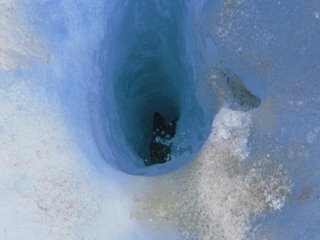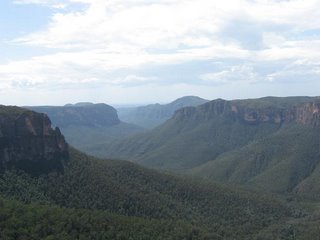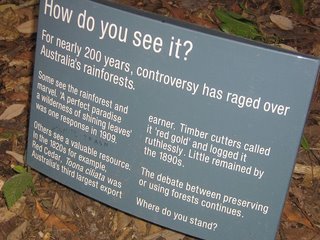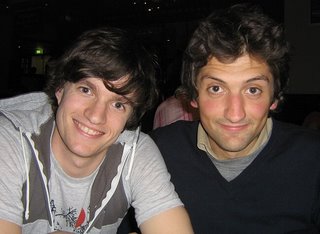 3rd November 2006, Day 227
3rd November 2006, Day 227Wellington, New Zealand
Don't let anyone tell you that two weeks in New Zealand is enough to see the country! I've just received confirmation that I'll be starting back at work in March. Despite the fact I am as far away from home as I could be without leaving planet earth, suddenly home seems to be staring me in the face with a protruding tongue.
Here's a little of what we've done in NZ, though I'll try to avoid offering too much opinion on the place because I haven't been able to make considered observations.
Other than some of the places in South East Asia we visited, I knew less about New Zealand than any other place on our itinerary so far. Trying to fit it in to 12 full days has meant big omissions from the usual tourist trail. Most backpackers/budget travellers tend to use one of the tourist buses to get around NZ - the Kiwi Experience (a kind of Club 18-30 type crowd) or the Magic Bus (a wider mix of ages and fewer three day benders). A few more use InterCity, the state bus service, and then there's people who just rent or buy a car/camper van. Because of the size of New Zealand it's possible to do a tour with Magic/Kiwi Experience and see most of the major attractions in the North and South Island in one 'go'. You can do a number of different routes and James and I were keen on one operated by Magic in the South Island. In the end we just didn't have the time necessary to do it and picked out the things we knew that we were desperate to experience. These fell neatly into three places: Rotorua and the Taupo Volcanic Zone, the Franz Josef glacier and Kaikoura. We booked trips to and fro across the Cook Straight to the South Island and got cracking.
Without planning on it, this was our first opportunity to follow a massive commercial backpacker route. Seeing as we haven't had much of that so far, we were looking forward to meeting a lot of new people easily and less time wasting over logistical guff. Now we're ten days into New Zealand we've have had a nice taste of this, which has cheered me up a bit after occassionally feeling adrift from my peers during the last seven months. I also found my favourite hostel ever in the South Island. We met a lot of Germans, which I thought was fantastic being something of a Germanophile (also I go a bit daft when I hear a girl with a German accent). So, a well worn track isn't always a rut.
Before I talk about the stupendous and often weird places we visited, it worth reflecting that we've used more dedicated tourist infrastructure in New Zealand than we have anywhere else. I generally don't think much about what impact I'm having when I choose to visit a destination; I think about the cheapest way of getting there. This is a default position for travellers and it has to be a conscious effort to think about the effect of your presence and cash in these areas. In a country like New Zealand which most people visit for it's natural beauty, the impact of the massive, constant tourist presence can have the effect of brusing and cutting into the landscape like constricting harness. The most interesting things to visit in NZ are often the places/creatures most delicate and susceptible to human interference.
 Having arrived in Auckland on a rainy labour day weekend, I was a bit shocked by the forbidding atmosphere. A lot of pissed up kids were hanging around on Queen Street looking for a fight. Not a great first impression. We decided to head for Rotorua the next day, which had been recommended by a few friends and one of the only ports of call on our sparse list.
Having arrived in Auckland on a rainy labour day weekend, I was a bit shocked by the forbidding atmosphere. A lot of pissed up kids were hanging around on Queen Street looking for a fight. Not a great first impression. We decided to head for Rotorua the next day, which had been recommended by a few friends and one of the only ports of call on our sparse list.New Zealand sits on the convergence of the Indo-Australian and Pacific tectonic plates. The continual friction between these two plates forces the Indo-Australian plate upwards (in simple terms) and creates volcanic and geothermal activity. Rotorua is in the Taupo Volcanic Zone, which contains all manner of bizarre geological sights, sounds and (mainly) smells. The zone fans out from below Lake Taupo in the centre of the North Island and follows an arc north towards Whakaari, the active volcano in the Bay of Plenty. 'Sulphur City' as Rotorua is known, stinks of rotten eggs most of the time and we didn't manage to get used to the aroma during the two days we spent there!
James and I took a morning's trip to one of the main geothermal sites which is a commercial tourist resort, Wai-o-tapu. In the picture above left, you can see some of the bubbling nutrient rich mud that people travel from all over the world to, in order to do their best hippo-mud-wallowing impression and emerge with smooth skin. The heat rising from the mud, geysers and pools creates an ethereal atmosphere as you walk around them. In Wai-o-tapu you can wander through the volatile crater lakes formed by acidic water which was forced up through the nutrient rich water table. Due to their geothermal nature, the lakes are fantastic spectrum of colours which are appropriately named things like 'the Champagne pool' and 'Aritist's palette'. It was a great place to get acquainted with New Zealand's outdoors and it's idiosyncracies.
 The Lady Knox geyser. A guide sets this off every morning at 10.15 by dumping a load of washing powder in it. It's a bit fraudulent, but if he didn't do it, I wouldn't have been able to take pretty pictures.
The Lady Knox geyser. A guide sets this off every morning at 10.15 by dumping a load of washing powder in it. It's a bit fraudulent, but if he didn't do it, I wouldn't have been able to take pretty pictures.Rotorua is one of the towns in NZ (or Aotearoa) with the largest Maori population and there's plenty of opportunity to experience Maori culture here. Sadly we didn't have the time to vist the Maori museums, but there is a rich history around the region. Wai-o-tapu, for instance, means 'sacred waters' and is holds a special place in with Maori legend. The Te Papa museum in Wellington will be our chance to educate ourselves a bit.
My flatmate of the last three years, who spent the best part of his life in NZ told me of the large gang culture which operates here, linked to racial division. I wasn't likely to encounter that in two weeks, but there were a few clear signs of racial tension. Whilst in a local boozer in West Port (S. Island) there was a lot of nasty casual racism ('I guess you've noticed the North Island's a lot browner than the south, eh, mate?'). This wasn't the only time I'd overheard these kind of remarks. By the same token, I also saw a bit of 'Black Power' graffitti in Rotorua, which I'm told is gang rather than a movement. I don't want to comment any further knowing nothing about Maori/Pakeha historical relations. It just seems that there's common divisions the world over.
 This a great view of the Southern Alps from the edge of Lake Wahapo on State Highway 6. This is typical of the scenery on the western coast of the South Island.
This a great view of the Southern Alps from the edge of Lake Wahapo on State Highway 6. This is typical of the scenery on the western coast of the South Island.It's common to hear tourists claim that the South Island is where you want to spend your time in New Zealand. On this untested advice we headed straight down to Wellington and across the Cook Straight to Picton after leaving Rotorua. The only way we were going to able to be able to cover the ground from Picton to the Franz Josef glacier, Franz Josef to Kaikoura and Kaikoura to Picton in the 6 days we had on the S. Island was to hire a car and do it on our own terms. Thanks again James - if you didn't offer to drive we wouldn't have seen all that amazing stuff (I lost my driving license in Thailand).
By serendipity, we were able to benefit from our sometime backpacking muse - our friends Dave and Jodie. After leaving Melbourne they'd gone on ahead of us to New Zealand and were heading back from South Island when we encountered them in Picton. Their experience was our gain and the first reliable advice we'd received since landing on NZ turf.
 Me on the Franz Josef glacier, S. Island.
Me on the Franz Josef glacier, S. Island.Once we hired the car we headed sraight down through Nelson and Murchison through the Buller Gorge, which was a lovely introduction to the dramatic scenery of the South Island.
We were desperate to get a car with some sort of stereo to break up the long periods of driving, but without paying through the nose we couldn't afford a CD player. We settled for a cassette player. Tapes are increasingly difficult to get your hands on these days, but James managed to find a second hand store in Murchison and purchased the following gems:
Truck Driving Hits (surprisingly enjoyable, if dubious in sentiment)
Iggy Pop - Blah Blah Blah (the album with the greatest content of filler ever recorded?)
Barry Manilow- Manilow (no one writes a tune like Baz)
...and last but by no means least, Hot Chocolate's Greatest Hits.
Driving through the Buller Gorge to the dulcet tones of Errol Brown crooning the tender ballad 'It Started with a Kiss' or with the windows wounds down listening to the foot stomping verve of 'Every 1's a Winner' will forever be associated in mind with the ravines and cloud of the South Island. Oh, and an important note: the 1987 Ben Liebrand remix of 'You Sexy Thing' is a big steaming pile of Stock, Aitken and Waterman inspired turd - though it made James laugh.
After an overnight stop in West Port, Franz Josef greeted us the following day with some of the most torrential rain of the last 7 months. It didn't put us off though, and despite waking up to the same conditions the next day, we were up on the glacier itself for a full day's hike a little after 11am. We did this through Franz Josef Glacier guides NZ, one of the two major operators. This is definitely in my top ten of things that we've done whilst travelling.
Glacial hiking has been a commercial acitivity on the Franz Josef for over a century now, but it is now regulated by the Department of Conservation. Strangely the focus of their attention, after doing a quick search on their website, seems to be managing visitor satisfaction rather than protecting the glacier itself. Perhaps that is now considered to be under control.
The glacier itself is under a period of advancing, though this is an anomaly in glacial activity worldwide which indicates that most glaciers are receeding (in terms of their total size) considered over a large number of years. This is a trend which scientist put down to climate change.
Wandering around on the glacier itself wasnt too difficult with the decent equipment provided by the guide operators. We were dry despite the prevailing heavy rain; weather which added to the atmosphere rather than detracting from it. Slipping past ice walls, hopping over crevasses and crawling through an ice hole. It was an altogether different realm from the 'back on the ground', and it was once of those things that quickly seems unreal when you reflect on it. James amazed me by hardly having a single problem with the heights all day.
 A Kea. This a type of parrot that only lives in Alpine regions (!), and it truly has a bold nature. Apparently it frequently pinches the glacier guides' lunch and despite frequent sighting it is endangered. Our tour guide mentioned that the way the birds amble up the glacier alongside you makes them look like they're taking the rise. I like them, they certainly had character.
A Kea. This a type of parrot that only lives in Alpine regions (!), and it truly has a bold nature. Apparently it frequently pinches the glacier guides' lunch and despite frequent sighting it is endangered. Our tour guide mentioned that the way the birds amble up the glacier alongside you makes them look like they're taking the rise. I like them, they certainly had character. A moulin or drainage hole for meltwater in the glacier. Virgin to the human gaze, I wish they'd had some sort of giant endoscope to poke down in order to view the natural, ingenious plumbing system running through the glacier.
A moulin or drainage hole for meltwater in the glacier. Virgin to the human gaze, I wish they'd had some sort of giant endoscope to poke down in order to view the natural, ingenious plumbing system running through the glacier.I was pleased at how much of the A-level glacial geography I recalled whilst I was on the tour. Long forgotten terms like moraine and the Rayleigh effect crept back from the recesses of my memory.
After leaving Franz Josef and stopping over night in the picturesque Hanmer Springs, we arrived at Kaikoura for the walk along it's famous peninsula and to see the wealth of marine life up close.
 A fur-seal hiding in the bushes at Kaikoura. I walking around to the seal colony with James, halfway along the Kaikoura coastal walk and saw a big crowd of tourists stood on the beach with a great view of some sun-bathing seals. In my rush to get a look, a cut off a corner and almost fell arse-over-tit when some thing growled and barked at me from the bushes. When I recovered, it turned out to be this rather grumpy and aloof looking individual. I didn't associate seals with gentrified car parks. Silly me.
A fur-seal hiding in the bushes at Kaikoura. I walking around to the seal colony with James, halfway along the Kaikoura coastal walk and saw a big crowd of tourists stood on the beach with a great view of some sun-bathing seals. In my rush to get a look, a cut off a corner and almost fell arse-over-tit when some thing growled and barked at me from the bushes. When I recovered, it turned out to be this rather grumpy and aloof looking individual. I didn't associate seals with gentrified car parks. Silly me.Wildlife rarely appears to be bothered by human presence in organised tourist facilities, but I think that's often a false impression. Clearly work by government agencies such as the Department of Conservation go someway towards stemming the negative impact of human presence in wilderness areas, but better public education on what is likely to cause problems is probably not as forthcoming as it might be. This is probably due to the contribution of tourism to the economy. Sometimes you've got to figure things out for yourself.
 The thing which brought about the biggest debate in my mind was the opportunity to see the Kaikouran marine life at close hand. Whale watching, seal swimming and dolphin cruises are all available at Kaikoura. After some quick research online, I decided to go swimming with the dusky dolphins you see to the left.
The thing which brought about the biggest debate in my mind was the opportunity to see the Kaikouran marine life at close hand. Whale watching, seal swimming and dolphin cruises are all available at Kaikoura. After some quick research online, I decided to go swimming with the dusky dolphins you see to the left.We used a firm called Dolphin Encounter. A strict tourist quota system is operated by the Department of Conservation, which only allows a certain number of dolphin swimmers in the water at any one time, and only at certain times of day so as not to disturb pods. Our guide happened to be conducting research for Earthwatch Australia/NZ an NGO, who work in partnership with Dolphin Encounter. She gave an impassioned speech on the plight of marine mammals which reassured me that the effect of these interactions were closely monitored. In addition, there was proper guidance given in a briefing video about respecting the dolphins and not touching them.
I am certainly glad we did go ahead. We got fully kitted up in wetsuits, boots, gloves, headmasks, snorkels and fins. When the horn sounded on the boat we slipped into a 12 degree pacific ocean at 6.15am. I admit I was thinking 'I wish I'd stayed in bed' when I first hit the water. All the equipment made it pretty difficult to swim, and my muscles tensed up a bit. After warming up the dolphins were around the vessel and we were 'entertaining' them with all our vigour. We were shown three ways to attract dolphins: swimming in circles, diving and replicated dolphin sounds. The latter method was probably just suggested for the amusement of the on-board crew. It took a bit of snooping around the bay in the boat and several dips until we got a full dolphin pod in our midst. This last swim was especially memorable and the were scores of dusky dolphins all around us, which is the kind of experience which nauseates people when you relate it, so I won't bother!
So what does the future hold for New Zeland's environment? A public-private partnership exists to sustainably fortify NZ's tourist industry. This supposedly embraces the maori spirit of manaakitanga (hospitality) and kaitiakitanga (guardianship). This has already succeeded in the creation of a NZ Ministry of Tourism. The 2010 strategy is proceeding as expected according the website. The online testimonies suggest that the economic element of sustainability seems to be holding up well, at least.
We'll be in South America, not long after you read this. We're not prepared for it at all, but at least our mate Roberto is waiting to cushion the impact when we arrive in Santiago. Hopefully work and reailty will be pushed into the corner of my mind one final time.



















